A quaint corner for avid sky watchers and space enthusiasts alike 🪐 All celestial observations and guides are made from a perspective of 4°N
Don't wanna be here? Send us removal request.
Text
The Summer Triangle

The summer triangle is a famous asterism in the northern hemisphere made up of 3 brightest stars from 3 constellations:
Vega (0.03) -a bright blueish star from Lyra the lyre. 26 LY away. (I can really see the light blue from my binoculars!)
Altair (0.77) - the 12th brightest star in the night sky from Aquila the eagle. 16.8 LY away
Deneb (1.25) - from Cygnus the swan. It is dimmest of the 3 even though it is a blue-white supergiant because it is 1500 LY away.
These 3 stars are so bright you can easily spot them in urban skies. From 4N, it can be seen as early as June after midnight rising above the eastern horizon as seen in this picture here, lying on its side. It can be seen all the way till early October. The first constellation that I always see will definitely be Cygnus as its 5 main stars makes up another asterism called the Northern Cross. Then followed by Aquila and lastly Lyra. I'd like to think the lyre's body as a parallelogram. Other than Vega, its other stars are quite dim and with the light pollution I see it clearly with my pair of cheap binoculars.
You can use the summer triangle to find north too!

Starting from Altair -> Deneb-> Vega-> Polaris. The pathway forms a "lightning bolt" pointing to the north star.

Another method involves imagining a mirror image of the triangle and move downwards from the tip of the triangle to find the north star a few degrees west. Honestly, I find the lightning bolt method much easier.
#astronomy#space#stars#stargazing#constellations#culture#history#amateur astronomy#cygnus#lyra#aquila#summer triangle
41 notes
·
View notes
Text
The Astrolabe

What's an astrolabe? its a celestial calculator, aiding in navigation by locating celestial bodies, finding latitudes of stars or even track celestial events. Basically, it's an old timey Stellarium™. Persian astronomer, Al-Fazari, is often credited with building the first astrolabe in the Islamic Golden Age. During this era, there were significant advancements in astronomy which explains why so many stars have Arabic names. Its usage was eventually phased out in the 18th century when sextants were introduced. Modern astrolabe replicas can be found even today as it is such a fascinating device.
I made an astrolabe to test it out
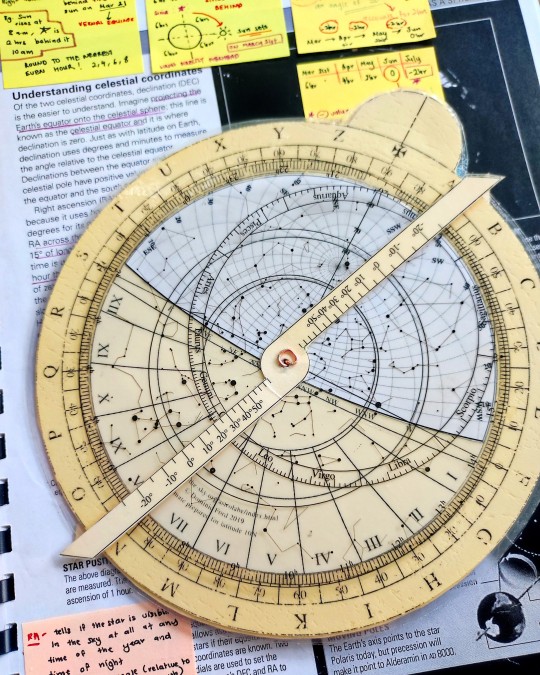
Well technically not really "made it" more like put the pieces together with glue and laminating paper after I printed out the templates from this website. The makeshift fastening pin was from cooper wires that I use for wire wrapping and I added a straw on the alidade as a sighting hole. It worked out in the end. I did tested it out and I won't say it is super accurate maybe the lowest latitude of the template I could get was 10N while I'm at 4N which could have contributed to its off-ness. Modern day astrolabes use clear plastic for the rete instead of brass with star pointers. So far I know how to tell the time from the stars. Still figuring out how to predict sunrise/set and determining the date using sun.
#astronomy#space#stars#stargazing#constellations#anthropology#culture#history#astrolabe#universe#ancient astronomy
1 note
·
View note
Text
THE GREAT Planetary Alignment of 2025
FROM TODAY ONWARDS till early Feb we will be able to see the most planets present in the night sky, a "planet parade"

25 Jan will be the best time to start an hour after sunset:

West: Saturn and Venus will be hanging low & close to each other
East: Jupiter is seen in Taurus near the bull's eye (aldebaran). Mars will be in Gemini. Uranus is there too but cannot be seen unless with a telescope Mercury joins in by the end of February 25-26:

You will be able to catch a glimpse of Mercury (very close to Saturn) but this can be quite tricky because it happens as soon as the sun is setting. It will also be very close to the western horizon.
124 notes
·
View notes
Text
Constellation: Centaurus

For stargazers living between the latitudes of 25°N to 90°S, look towards the southern skies for Centaurus as May approaches.
Being the 9th largest constellation, it covers an area of 1060 square degrees. This particular patch of sky has a lot to offer since it is embedded in a splendidly bright and intricate part of the Milky Way. For me, the entire expanse of sky encompassing Scorpio, Sagittarius and Centaurus? *chefs kiss* (There are so many interesting deep space objects to see in Centaurus so I’ll probably talk more about it in another post)
For most of the illustrated star maps, Centaurus was always shown to be spearing or sacrificing Lupus, the adjacent wolf constellation. It is said to represent an ancient pagan festival known as Lupercalia and Centaurus is bringing Lupus to the sacrificial altar, Ara. In Babylonian culture, the constellation was depicted as the Bison-man and associated it with their Sun god Utu. Others relate the constellation to the wise Chiron, mentor of great Greek heroes such a Achilles, Asclepius and Heracles to name a few.
Stars of Centaurus

Its a wonderment to stare at this patch of sky since it contains approximately 281 stars below the mag. 6.5 (the dimmest stars that can be observed by the unaided eye) within its borders. It can be overwhelming but 11 main stars can be joined to resemble the outline of a classical centaur. Only 9 stars have official names recognized by the IAU. I have them labelled in the image above along with the meanings behind those names for a lil trivia. The names are mostly of Arabic and Chinese origins.
It boasts magnificent star clusters and home to the two brightest stars of the night sky. Leading the way are Rigel Kentaurus (α-cen) and Hadar (β-cen) forming the front feet of the centaur. These 2 stars are also an important asterism in navigation as mentioned in a previous post called as “the pointers” aiding in identifying the Southern Cross. Holding the position as the 4th and 10th brightest star in the night sky, α & β-cen blazes at an apparent mag of -0.27 & 0.61. They are hard to miss.
Rigel Kentaurus is a triple star system consisting of:

Rigil Kentaurus itself (α-centauri A) & Toliman (α-Centauri B)- 2 sun-like stars locked in a binary orbit of 79.9 years.
Proxima Centauri (α-Centauri C) – An 11th magnitude red dwarf that needs a telescope to be seen. Famously known as the closest star to our Sun only 4.24 LY away. Only discovered in 1915 since it was so faint. It is an outlying member of the triple star system with an orbital period around 550,000 years!
I must at least mention the Omega Centauri Cluster

That fuzzy spot on the centaur's back is one of the oldest star clusters. Believed to be at least 12 million years old. Almost as ancient as the universe itself. It is also the largest known globular cluster in the Milky Way, estimated to have 1 million stars. This cluster holds many titles along with being the closest cluster to our solar system at 17,000 LY away. With that, it shines as the brightest globular cluster in the night sky.
Identifying Centaurus
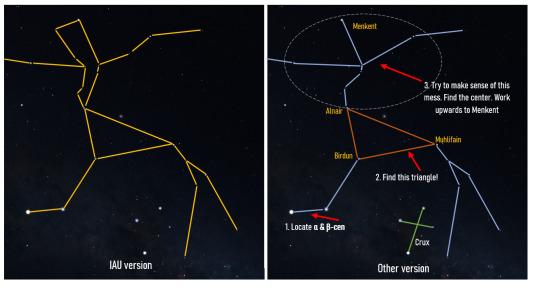
There are 2 known patterns for Centaurus as you can see here. The one on the left is official pattern recognized by the IAU. The right side is more commonly used in other star maps or references. When it comes to identifying constellations, its better to stick with anything less convoluted so we'll go for the right side. This version simplifies Centaurus's upper body into a stick figure.
The easiest way to locate Centaurus is by looking for Crux first facing southward. The pointers (α&β-Cent) & Crux are basically a matching set and the fact that they are fairly bright stars make it even easier to locate! Once you got the Pointers, make your way up to Alnair, Muhlifain & Birdun. These are fairly bright stars of mag. 2 that form a right-angled-triangle-lower-body. When you get a hold of that triangle, you're all set! Simply move upwards and try to visualize a stick figure.
Most of the stars that make up the torso are quite dim (mag. 2.5 -4) making it even harder to make anything out of it for beginners. I used to call that area as "a huge mess" It helps to start from Alnair (top of the triangle) and go upwards to the center, Mu & Nu- Cent. Then, upwards to Menkent, a fairly bright orange star of app. mag. of 2.04. From there work your way out to the arms. Same goes for the hind legs. Best time to view the centaur is in May where it is fully upright in the sky in its full glory at 10pm onward.
Happy star hunting!
#astronomy#stargazing#space#stars#constellations#nature#navigation#chiron#constellation#centaurus#alpha centauri#universe
0 notes
Text
Here's some sunset pictures I took:
Not my usual space posts but the SKY is sort of related to space. I might as well share some sunset pics that I took over the years with my phone.

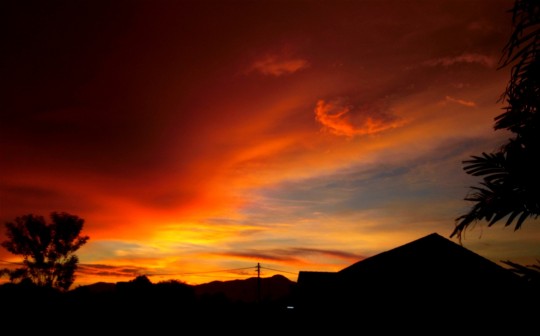

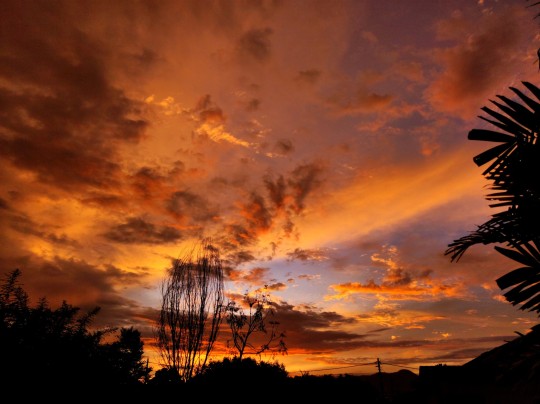
Other planets can be cool with their perpetual storms or diamond showers but do they have marvelous sunsets like the Earth? Don't think so! It's undeniable that sunsets on Earth are amazing and you'll probably never see anything like it anywhere else in the universe. Let us all bask in its beauty!
And no two sunsets are alike so each time you observe a sunset, know that you'll only be seeing it once! Oh how wondrous the sky can be!
As usual click on the pics for better quality
Location: where I live
#sunset#sunset photography#nature#nature photography#sunsets#oh i fucking love sunsets#the sun is setting?#you bet your ass im gonna take a pic of it#sky#clouds#sky photography#space#astronomy#do you love the color of the sky#yes i fucking do
19 notes
·
View notes
Text
˚*•̩̩͙✩•̩̩͙*˚

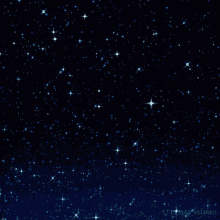
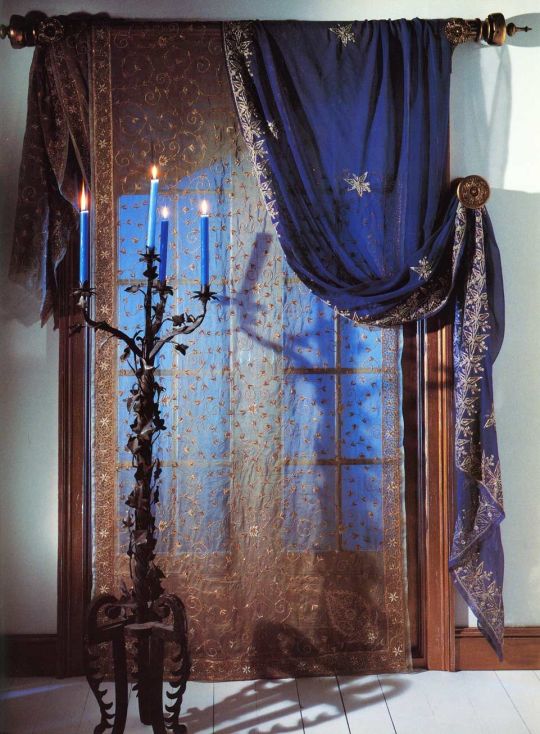
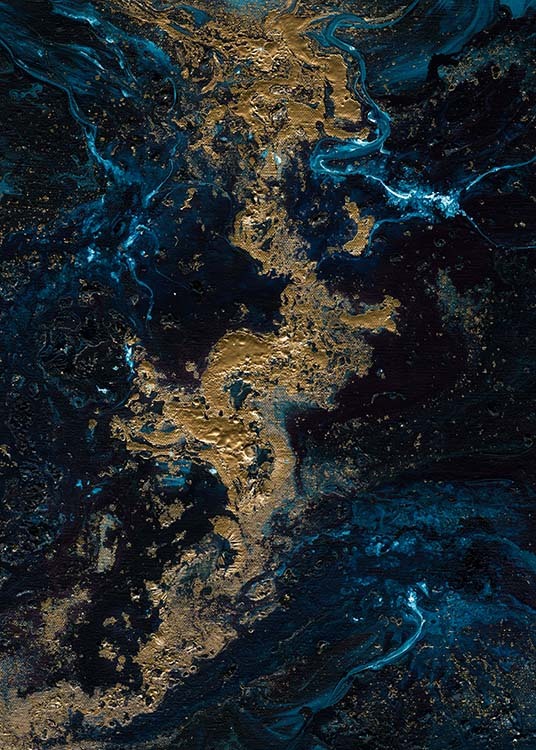

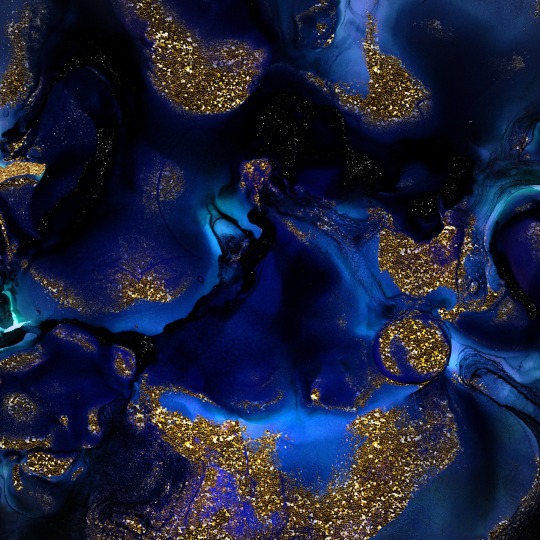
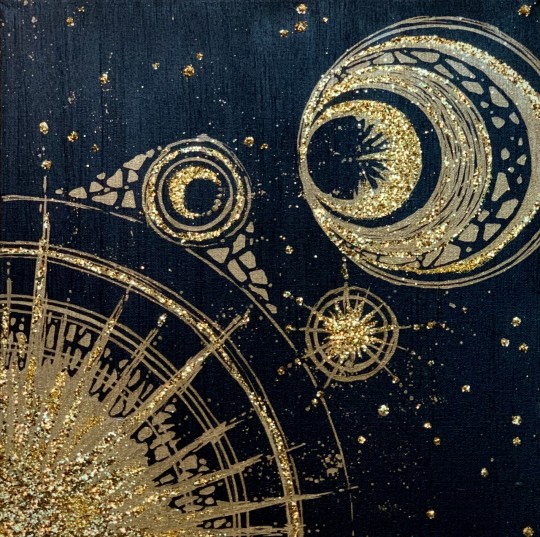
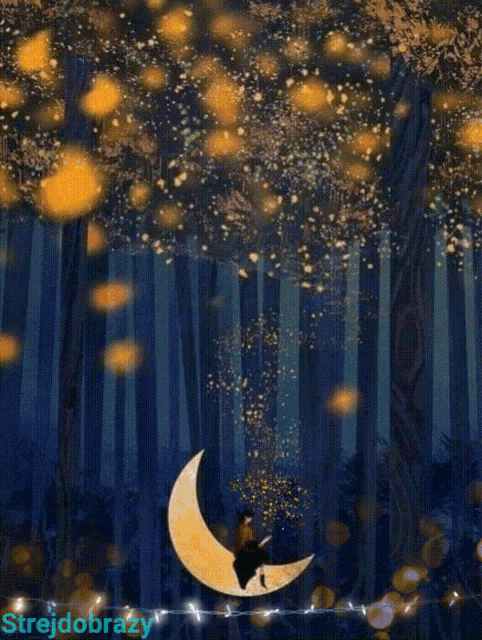

4K notes
·
View notes
Text

Like a shiny, round ornament ready to be placed in the perfect spot on the holiday tree, supernova remnant Cassiopeia A gleams in a new image from the James Webb Space Telescope.
Webb’s high-resolution look at Cassiopeia A in the near-infrared is adding to the treasure trove of information from the telescope’s recent image taken in mid-infrared light.
The most noticeable colors in Webb’s near-infrared image are clumps of bright orange and light pink that make up the inner shell of the supernova remnant. These tiny knots, comprised of sulfur, oxygen, argon, and neon from the star itself, are only detectable by its Near-Infrared Camera’s exquisite resolution, and give researchers a hint at how the dying star shattered like glass when it exploded.
The outskirts of the main inner shell, which appear as a deep orange and red in the mid-infrared image, now look like smoke from a campfire in near-infrared. This marks where ejected material from the exploded star is ramming into surrounding gas and dust.
Credit: NASA, ESA, CSA, STScI, D. Milisavljevic (Purdue University), T. Temim (Princeton University), I. De Looze (University of Gent).
314 notes
·
View notes
Text
Deep Space Objects: Crux, The Southern Cross

Crux sits in the heart of the Milky Way, making this a wonderful spot for dazzling deep space objects.
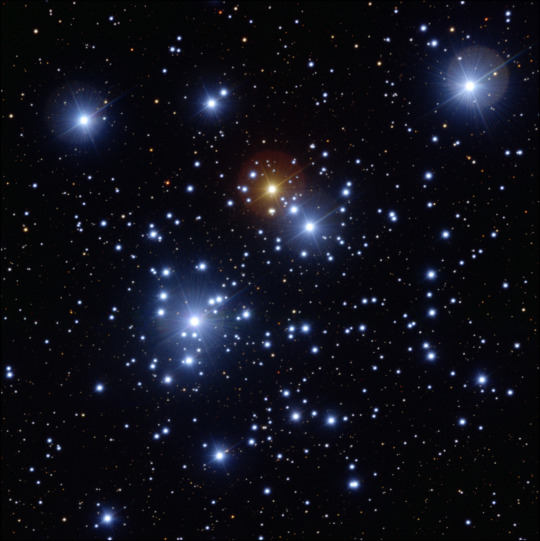
Jewel Box Cluster (NGC 4755)
Located at an approx. distance of 6440 LY from Earth, it is regarded as one of the finest open star clusters. It resembles a fuzzy star of mag. 4 to the naked eye. With just a good pair of binoculars, its 4 bright multicolored stars form an A-shaped asterism. One of the main stars is a red supergiant and stands in contrast to the nearby luminous, massive blue stars. They are also referred as the "traffic lights" due to its varying colours. The name was originates from John Herschel's description: "...this cluster, though neither a large nor a rich one, is yet an extremely brilliant and beautiful object when viewed through an instrument of sufficient aperture to show distinctly the very different colour of its constituent stars, which give it the effect of a superb piece of fancy jewellery."
Coal Sack Nebula (Caldwell 99 / C99)
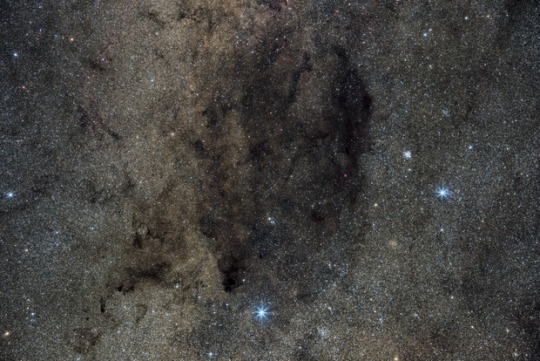
Through the naked eye, it appears like as if someone cut a hole in the star-filled milky way. It does not signify an absence of stars, but rather is formed by thick interstellar dust clouds obstructing starlight from behind. This dark nebula is approx. 600 LY away, one of the nebulae close to us.

In Australian aboriginal culture, the Coalsack is recognized as the head of an Emu and Great Rift that trails all the way to Cygnus makes up the body and legs. Depends on where you are, the emu could be lying on its belly or upright. (Pic) Imagine a floppy yellow rubber chicken.
NGC 4103
One of the less significant open clusters in Crux along with NGC 4349 & NGC 4609. It has moderately bright stars. It is a fairly young open cluster located 5000 LY away from Earth.
1 note
·
View note
Text
Constellation: Crux, The Southern Cross
Crux may be the smallest out of the 88 constellations but it is certainly not to be passed by. Simple and compact, it is a distinctive cross made up of 4 bright stars. Acrux (α-Cru) and Mimosa (β-Cru) are multiple star systems. The double star to look out for is Acrux which is distinguishable by a telescope revealing twin blue-white stars of magnitude 1.3 and 1.7. The red giant Gacrux (γ-Cru) of mag 1.6 contrasts with the constellations other blue-white stars with its notable reddish hue. The pulsating variable, Imai (δ-Cru), is the dimmest out of the 4 which shines with an apparent mag of 2.8. There is a 5th star, Ginan (ε-Cru) that is not included as part of the cross but crucial when it comes to identifying the cross. With a mag of 3.58, this orange giant star can be snuffed out in light polluted skies.

Like its northern counterpart, the big dipper, Crux can be used as a signpost to find the south celestial pole. It can be quite confusing since any random stars can be used to form a cross in the sky. The False Cross asterism is a common navigation error when 2 stars from Vela and another 2 from Carina was mistaken for the Southern Cross constellation. 4 neighbouring stars from Carina also form another asterism called the Diamond Cross. The key is to always look out for a lil star, ε-Crucis, between Acrux (α-Cru) and Imai (δ-Cru). They are almost in line with each other. Another key element is that Crux will always be accompanied by The Pointers, consisting the stars Rigel Kentaurus (α - Cen) & Hadar. (β- Cen). They are 2 stars of somewhat equal brightness from the constellation Centaurus just east of Crux.
How to find south with Crux and the Pointers
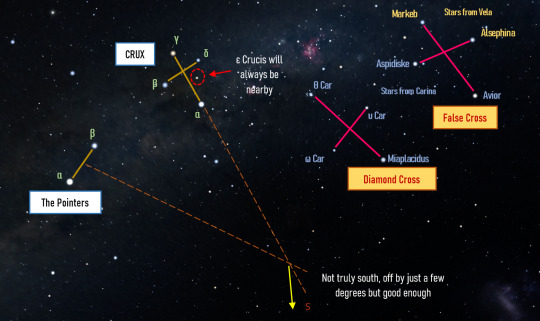
Firstly, perpendicularly bisect the line formed by α & β-Cen and extend the line all the way down. Then followed by a straight line going downwards from γ-Cru to α-Cru. The point where these 2 lines meet will mark the southern pole.

Where to look? (From a perspective of 4°N)
Being a prominent southern hemisphere constellation, those living way down south will see it as a circumpolar constellation meaning it will never set. If you're living in latitudes above 20°N, it will not be visible. In the picture, I've included the "Pointers" as well for ease of identification and orientation. From 4°N, Crux can be seen as early as April at sundown at SSE. Both the Pointers and Crux are fully visible late April. Best time for viewing will be in May where it is high up in the sky when you're facing exactly South (Duh). As July went by, it makes its way towards western horizon. It will not be seen again until January but only appearing in the wee hours of the morning.
#astronomy#space#stargazing#stars#southern cross#Crux#navigation#amateur astronomy#universe#constellations
7 notes
·
View notes
Text
Venus Approaching Greatest Elongation
The “evening star” takes center stage this month and all the way till June as soon as the sun sets. Venus hangs about 25° above the horizon upon sunset and outshines everything other than the moon. Venus will continue to inch higher in the sky with every sunset up to its greatest elongation on June 4th with its highest altitude at 43°. This also gives us about 3½ hours to observe Venus before it sets every night. Just from observation, Venus blazes with a distinct golden hue at magnitude -4, (a whooping magnitude -4.5 at greatest eastern elongation!)

Venus also passes by the seven sisters from 8th – 14th April. A great astrophotography opportunity for sky watchers. Venus will be closest to the Pleiades on 10th – 11th April, just 2.5° from each other.
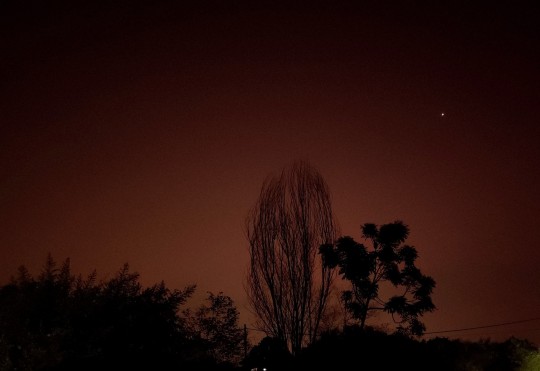
Venus is so bright, it is visible even in the dusty twilight sky through the lens of my crappy phone camera. (That lil white dot on the upper right)
0 notes
Text
The most beautiful thing 🌙✨
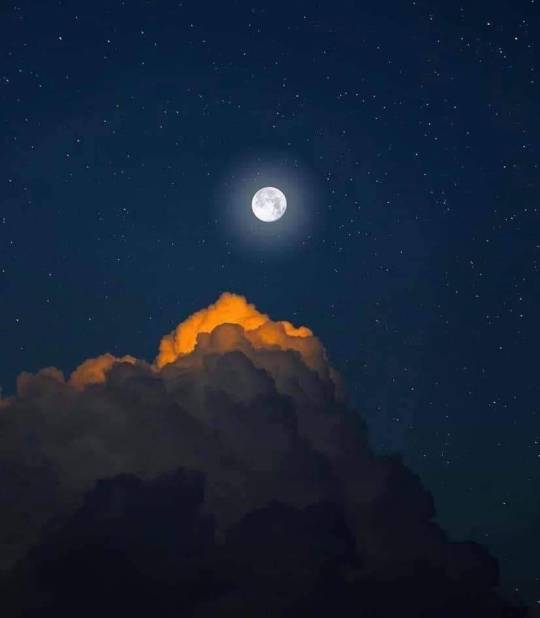
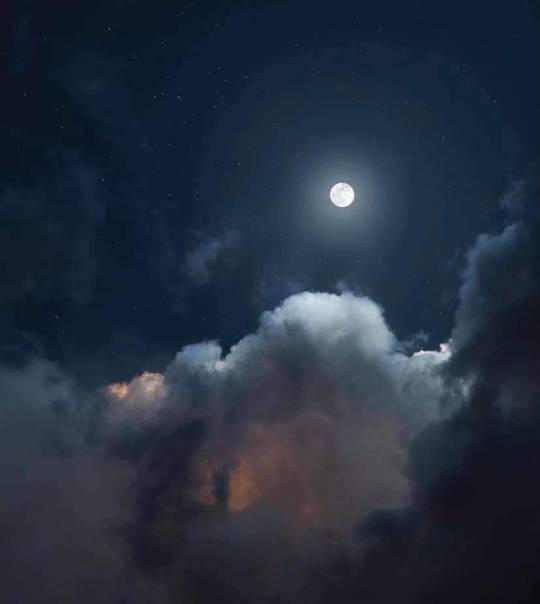
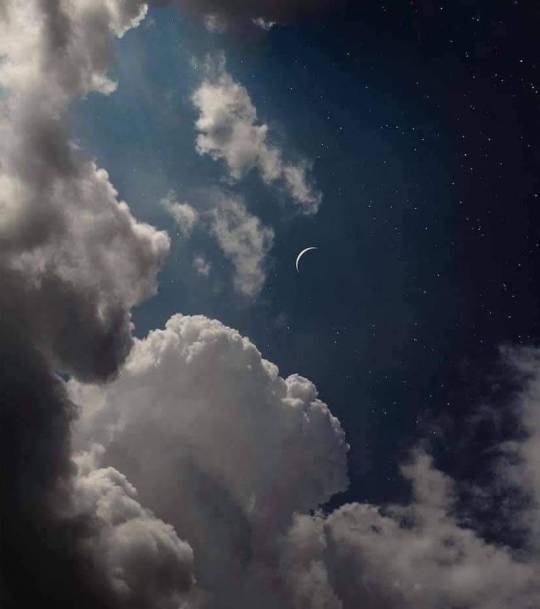
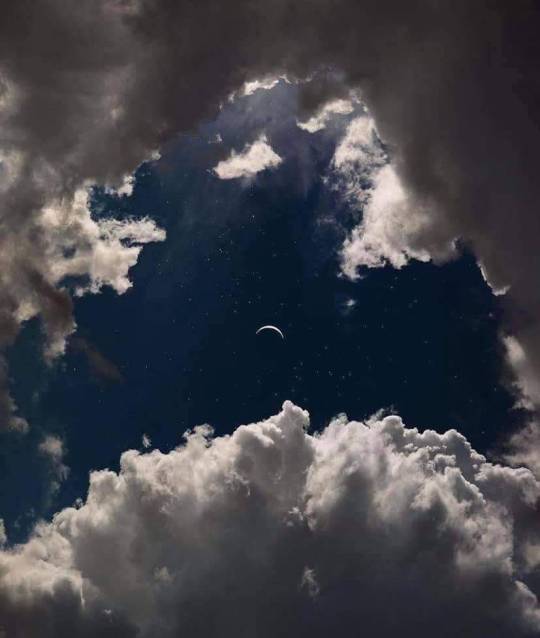
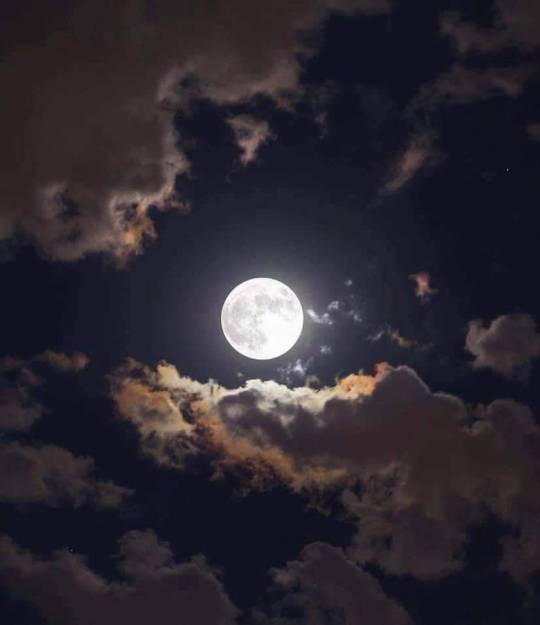
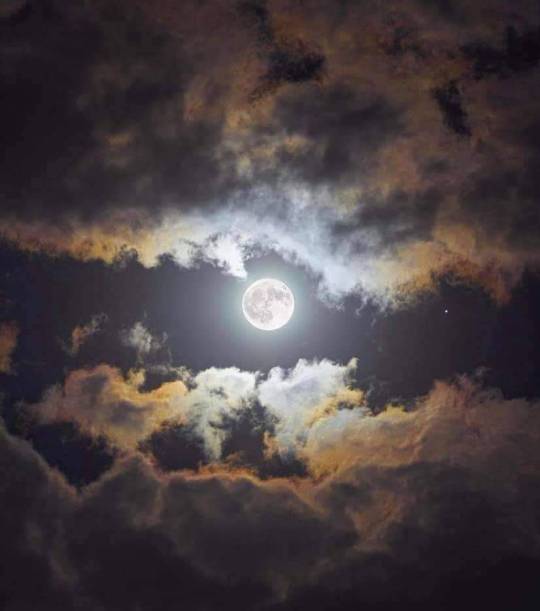
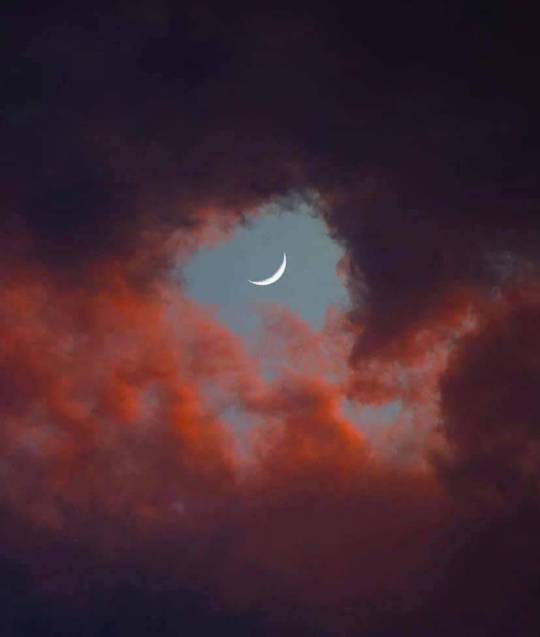
2K notes
·
View notes
Text
There really is such a softness in knowing that you look up at some of the same stars as people who lived 5000 years ago did.
16K notes
·
View notes
Text
The Pleiades

As November approaches, Pleiades makes its appearance again! The Pleiades or Messier 45 is associated with the coming of winter in the northern skies. This open star cluster was nearly always imagined as a group of seven sisters by myths across cultures. The one which we are most familiar with is the Greek myth of Zeus transforming them into doves and flew to the heavens to protect them from Orion. It is one of the nearest star clusters to Earth and easily visible to the naked eye. Its brightest stars lie at a distance between 390 and 460 light years. The cluster is mostly composed of hot, blue, highly luminous stars belonging to the spectral class B estimated to be under 100 million years old.

The brightest stars in the cluster represent the Pleiades, the Seven Sisters in Greek mythology, Maia (+3.86), Electra (+3.70), Taygete (+4.29), Alcyone (+2.86), Celaeno (+5.44), Sterope (+5.64), Merope (+4.17). and their parents, the nymph Pleione (+5.09) and the Titan Atlas (+3.62). Merope, the youngest, was often depicted as the lost pleiad for she was ashamed for marrying a mortal, Sisyphus. Hence, she hides in shame and shines dimmer than her sisters. Another theory on the explanation of the lost pleiad is on the movement of stars across space throughout time. This explains why people in the past were only able to see 6 instead of 7.

Many claimed it to look like a “tiny dipper” but personally it looks like a tiny cross made up of the 5 brightest stars. Beginners will often see 5 of them, which makes sense since Alcyone, Atlas, Electra, Maia, and Merope are at a magnitude of 2 - 4.
It can be seen as early as late October all the way till April. (Note this is from a perspective of 4N, looking towards east, so it may look upside down) To locate Pleiades, look for Orion’s trusty belt made of 3 stars. To confirm you are extending the line from the right side of the belt, Betelgeuse (reddish hue) should be at the bottom and Rigel at the top. (Vice versa for Betelgeuse and Rigel’s position at later times of the year when the constellations begin to set west.) Then, draw a straight line from the belt upwards to a bright orange star, Aldebaran, the eye of the bull. To confirm again its the correct star, Aldebaran will be surrounded by a V-shape of stars called the Hyades which makes up the bull’s face. Lastly, extend the line diagonally upwards again and you will reach Pleiades.
#pleiades#seven sisters#space#astronomy#taurus#stars#universe#stargazing#star gazer#constellation#the universe
5 notes
·
View notes
Text
Boötes Void

When it comes to deep space objects, Boötes has not much to offer since it faces away from the plane of the Milky way galaxy. While there are some faint galaxies and globular clusters, what interests us is the “lack thereof” when it comes this particular patch of sky: The Boötes void. If we are to look at the area between the tip of the plow’s handle and near the head of Boötes, we are peering into “The Great Nothing”. The Boötes void is however, not completely empty as the name implies. It simply has a sparse number of galaxies in an enormous region of space compared to the rest of the universe.

Take the famous Hubble Deep Field image for example. Hubble stared at a seemingly empty small patch of sky (1/30th the size of a full moon) for 10 consecutive days and the result was an image mosaic containing 265,000 galaxies. Now compare it with the Boötes void that is nearly 330 million LY in diameter with only 60 discovered galaxies by 1997. It is estimated that the void should consist of approximately 2000 galaxies using the rough estimate of 1 galaxy every 10 million years, which is still quite lonely in a huge expanse of space.
An image of Barnard 68 (a dark nebula or molecular cloud) is commonly misused as the Boötes void

This is the Boötes void

A huge patch of space that stretches for a million light years with a few lonely galaxies scattered across it.
20 notes
·
View notes
Text
Constellation: Boötes

Boötes is a fairly unremarkable constellation that dominates its fainter galactic neighbors at a rather quiet patch of sky. It still has a recognizable kite shape that can be easily spotted. Boötes is Greek for herdsman or plowman, often depicted holding a club and accompanied by his hunting dogs (Canes Venatici).

The mythology behind Boötes is most commonly of Arcas, Son of Zeus and Callisto, daughter of King Lycaon. Hera yet again punishes the victims instead of her husband for infidelity by transforming Callisto into a bear. Arcas encountered his mother in the woods years later. Unable to recognized her, chased her like any other bear to be hunted. Zeus placed both of them in the sky as Ursa Major and Boötes to avoid the tragedy that was about to unfold.
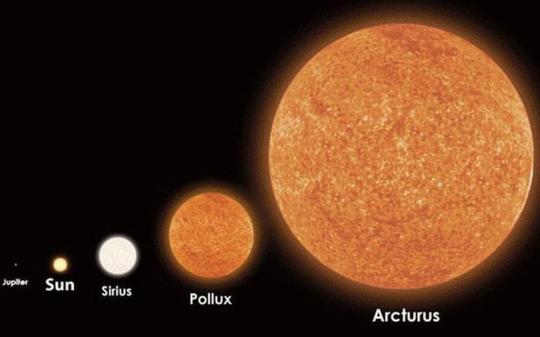
The major stars of this constellation form a kite shape with its main star Arcturus (Alpha Boötis) located – ahem – at its “southernmost tip” (those saying its his foot is just being appropriate). Arcturus is a red giant that sits at a distance of 75 light years from our solar system. It also takes its place as the 4th brightest star in the night sky. Arcturus blazes with a golden hue at the magnitude of -0.04. Arcturus is nearing the end of its life, burning up all its fuel and swells up into a red giant 25x that of the Sun with a diameter of 35 million km.
Another star worth mentioning is Izar (Epsilon Boötis), a fine binary star (2.37) approximately 203 light years from us. It is a colorful binary star system comprised of an orange giant (Epsilon Boötis A) [2.37] and a blue-white main sequence star (Epsilon Boötis B) [5.12]. Its components can be resolved with binoculars or a telescope.

To find Boötes, starhop from the handle of the plow to Arcturus or “Arc to ARCturus”. This is relatively easy since Arcturus is the brightest star at that lonely patch of sky so its hard to miss. Then the rest of its dimmer stars (Mg 2.5 - 4) that make up its kite shaped body will jump out.

This is how Boötes would look like from 4N. Rises from NE as early as mid may and full in view from 9pm onwards. Arcturus will be on the left side upon rising and vice versa towards setting. From June until July at 9pm it will be upside down and its head roughly pointing N. Last chance to see it will be until early september 8pm. Note that the cardinal points are just a rough estimate on which direction to look.
2 notes
·
View notes
Text
Constellation: Scorpius / Scorpio
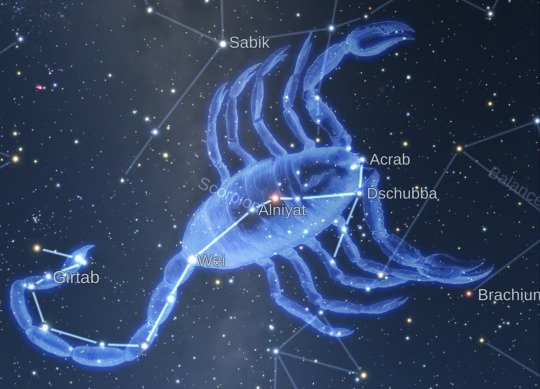
One of the notable zodiac constellations, Scorpius lies among the starry parts of the northern summer sky. Since it is located near the center of the milky way, there are many deep sky objects to look out for.
In Greek mythology, Scorpius was associated with the constellation Orion. Scorpius was sent by Hera/Gaia (there are many variations to the story) to kill Orion when the hunter boasted there was not a beast in the world that he could not defeat. These two constellations never appear on the same night sky as Orion sets while Scorpius rises in the east. It appears as if Scorpius is still chasing Orion across the heavens. It has a distinguishable thread of stars that curves its way into a hook at its tail which brings us to a Hawaiian mythology, Maui’s fishhook, Manaiakalani. Maui hauled up the islands of Hawaii with his great fishhook while on a fishing trip with his brothers. His hook caught the ocean floor but he tricked his brothers by telling them it caught a huge fish so he told them to keep paddling as hard as they could and never look back. Thus, the Hawaiian Islands were formed. Scorpius used to have claws made up of stars that now belong to another constellation, Libra.

Antares is the brightest star of Scorpius. It is a double star (Antares A & Antares B) that fluctuates in brightness from 0.9 to 1.2 every 4 to 5 years. Antares A is a red supergiant 10000x brighter and 850x in diameter of the Sun. It’s companion, Antares B is only 10x the diameter of our Sun and dwarfed by its massive parent star. Its name translates to “Anti-ares” or “Rival of Mars.” A fitting name due its similar hue to the reddish planet.
Notable deep sky objects include: (There are more..)

Butterfly Cluster (M6) - Squint to vaguely see the shape of a butterfly-
Ptolemy Cluster (M7)
The Table of Scorpius / The Northern Jewel Box (NGC 6231)
Prawn Nebula (IC 4628)
Where to look ( Perspective from 4°N) :

Scorpius can be seen as early as Mid June and rises from SE. It will make its way to SW as September approaches. By the end of September, Scorpius will be seen lying on its side with its neighbor Sagittarius above it. Personally, I usually spot Scorpius by looking for Antares first then followed by 3 stars that make its head/claws near Antares then the rest of its hook tail can be easily made out. Antares is bright with an orangey hue. Easily spotted even in suburban skies. Most of the stars in Scorpius are fairly bright (Magnitude >2)
9 notes
·
View notes
Text
Ancient Star Maps
A complex of caves located in southwestern France is home to the famous Lascaux cave paintings. Estimated to be over 17,000 years old, these cavern walls display splendid paleolithic paintings of over 6,000 figures of animals, humans and abstract symbols. From an astronomical point of view, what piques our interest is a painting of a bull surrounded with "dots". Experts suggests that these could be evidence of ancient star maps. Above the bull is a cluster of dots which could represent Pleiades or The Seven Sisters. On the left, a short line of dots are suspected to be Orion's belt.

"There are further similarities comparing the rock picture and the delivered iconography of the bull constellation. Five spots of medium size and seven or more smaller one are speckled in a pattern over the face.." "A further large dot with a half bow drawn across it indicate the eye with a brow. If hypothesis is right that the first set of spots floating above the animals back represent the Pleiades, then one can presume the second one indicates the other open cluster in Taurus, the hyades, distributed around the main star Aldebaran" (Rappenglück Et al, 1997)
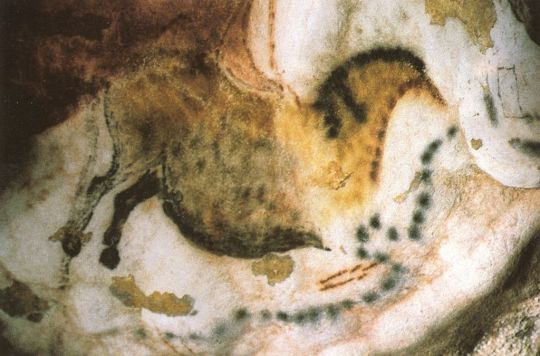
Another painting of a horse with dots could be the oldest lunar calendar ever created. The dots painted depict a 29 - day cycle of the moon. Through these cave paintings, its amazing to know that humanity's wonderment towards the heavens has remain unchanged throughout history.
Dr. Rappenglück’s study can be found here if anyone is interested to have a more in-depth look
11 notes
·
View notes